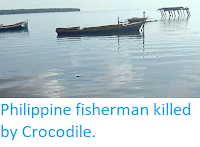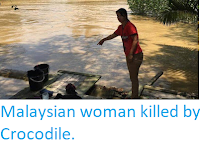A South African woman has died in hospital several days after being attacked by a Nile Crocodile, Crocodylus niloticus. Mavis Mohlala, 39, was attacked at about 7.00 pm on Saturday 5 October 2019, while crossing the River Lepelle (Olifants) on her way to a church service in Kolokotela Village in Limpopo Province. The Crocodile was beaten off by fellow churchgoers with sticks before she could be dragged away, and Ms Mohlala taken to the Matlala Hospital for treatment, where she died on Wednesday 9 October. Her family have raised concerns about her treatment at the hospital, and in particular why she was not transferred to the better equipped Mankweng Hospital in Polokwane, where they believe she would have received better treatment. Villagers in Tsimanyane Village, where Ms Mohlala lived, have been campaigning for a bridge to connect them to Kolokotela for several years.
A Crocodile on the Boshielo Dam Reservior on the Lepelle River, close to the Tsimanyane/Kolokotela crossing. Botha (2005).
Conflicts between Humans and animals present a major challenge in conservation work, particularly where animals are prone to attacking Humans or livestock. The most common perpetrators of such attacks in Africa are Crocodiles. Nile Crocodiles are particularly dangerous, with the largest males reaching around five metres in length, and a diet that includes animals such as Wildebeest, Connochaetes spp., and Buffalo, Syncerus caffer, species which it requires considerable strength to subdue. Crocodiles are extremely versatile in their environmental tolerances; they are semi-aquatic, but dwell in a range of habitats from large, fast flowing rivers to small ponds, and have quickly colonised Human-made environments such as canals, dam lakes and even irrigation ditches, creating extra opportunities for conflict with Humans.
Nile Crocodiles are considered to be of Least Concern under the terms of the International Union for the Conservation of Nature’s Red List of Threatened Species, but are still protected in many countries, due to historic hunting which decimated populations in many areas. However, the rising number of attacks on Humans by the animals has led to calls for regulated hunting to be introduced to control the population.
See also...
Follow Sciency Thoughts on Facebook.







